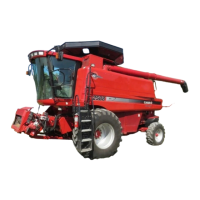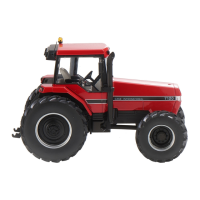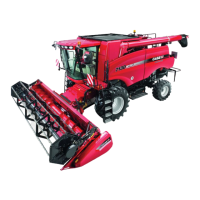22
TROUBLESHOOTING
Increasing the Efficiency of Axial-Flow
Combines in Tough Harvest Conditions
These suggestions have helped many combine operators
increase their efficiency in challenging conditions:
• If congestion becomes a problem in green, weedy crop
conditions, reduce the rotor-to-concave clearance and/or
increase the rotor RPM to help the green material move
through the rotor cage. This applies to all Standard,
Specialty, and
AFX rotors.
• Some operators have improved the movement of green
material through a standard rotor with minimum grain loss
by installing notched separator bars on the rotor over the
separator grate area
• When harvesting hard-to-thresh grains with any rotor, help
the combine complete the threshing operation by retarding
two or more of the transport vanes to the slow position over
the concaves, beginning with the first two vanes. For very
severe hard-to-thresh conditions, such as a heat-stressed
crop, interrupter bars can be installed in the concaves.
• In most cases, however, once the desired concave clearance
is set, the best way to achieve ideal operation is to vary rotor
speeds. Another plus for the AXIAL-FLOW concept.
Optimizing Straw Quality
The grain-on-grain and rubbing nature of the Axial-Flow
combine threshing and separating system can inherently
reduce straw length, making baling straw challenging in some
conditions. Some specific settings and harvesting conditions
can be implemented to help produce longer length and quality
straw. Special settings tend to reduce threshing and separating
performance, so a balance of straw value and grain loss must
be determined when making adjustments.
Reduce aggressiveness of rotor and move material
through the rotor cage quickly:
• Standard rotor—remove the first two sets of straight rasp
bars if threshing is not impaired. Use smooth (not notched)
separator bars.
• Specialty rotors—remove the straight separator bars and
replace them with rasp bars. Do not use spiked rasp bars
unless necessary due to trashy conditions.
• Reduce rotor speed and open the concave, but maintain
threshing and separating performance
• Adjust transport vanes over separator grates to the fast
position
• Adjust transport vanes over the concave area to the mid or
fast position
Configure rotor cage for smoother material flow:
• Use small wire concaves, or at a minimum, in the first
concave position
• Use slotted grates with bars on the outside in the 1/2 hole
position
• If grain loss is not an issue, use solid separator grates in
the second and third positions
Other machine settings:
• Use a combine with discharge beater instead of straw chopper
• Lower chopper/beater pan to the “Corn” position
• Retract the straw chopper concave and/or reduce chopper/
beater speed
• Reduce rock trap beater speed
• Remove straw spreaders
• If straw is being driven into the stubble, leave spreader
discs in place, but remove spreader bats or angles
Harvesting conditions:
• Harvest when straw is tough, usually during damp conditions
such as early morning or late evening
•
Cut stubble lower for longer stems

